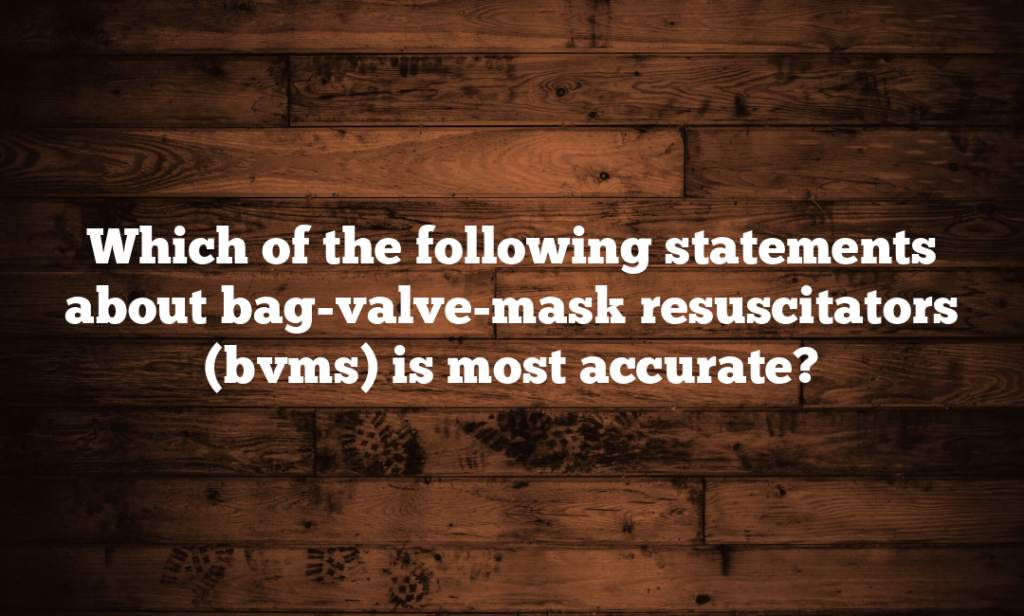Which of the following statements about bag-valve-mask resuscitators (bvms) is most accurate?
In emergency medical situations, the bag-valve-mask (BVM) resuscitator plays a critical role in providing life-saving ventilation to patients. However, there are often misconceptions and uncertainties surrounding its proper usage and effectiveness. In this comprehensive guide, we will delve into the reality of BVM resuscitation, offering expert insights and practical advice for healthcare professionals.
Understanding Bag-Valve-Mask Resuscitation
Bag-valve-mask resuscitation is a manual ventilation technique used to deliver breaths to patients who are not breathing adequately or at all. It consists of a self-inflating bag, a valve mechanism, and a face mask. When properly administered, the BVM provides positive pressure ventilation to oxygenate the lungs and support respiratory function.
The Importance of Proper Technique
Effective BVM ventilation relies on the proper technique. Healthcare providers must ensure a proper mask seal, maintain an open airway, and deliver breaths at an appropriate rate and volume. Failure to adhere to these principles can result in inadequate ventilation, leading to hypoxia and other complications.
Common Myths and Misconceptions
Despite its widespread use, there are several myths and misconceptions surrounding BVM resuscitation. One common myth is that the BVM alone can guarantee adequate oxygenation. In reality, proper technique, monitoring, and adjustment are essential to ensure effective ventilation.
Another misconception is that BVM ventilation is simple and foolproof. While the basic concept is straightforward, mastering the technique requires practice, skill, and ongoing education. Healthcare providers must be trained to recognize and address challenges such as air leaks, gastric insufflation, and patient factors that may affect ventilation.
Expert Recommendations
To optimize BVM resuscitation outcomes, experts recommend a systematic approach that includes the following:
- Training and Education: Healthcare providers should receive comprehensive training in BVM ventilation, including hands-on practice and simulation-based learning. Regular refresher courses and skills assessments are also essential to maintain proficiency.
- Equipment Selection and Maintenance: Quality BVM equipment is crucial for effective ventilation. Providers should ensure that equipment is properly assembled, calibrated, and maintained according to manufacturer guidelines. Regular equipment checks and replacement of worn components are essential to prevent malfunction.
- Team Communication and Coordination: Effective teamwork is essential during BVM resuscitation efforts. Clear communication, role assignment, and coordination among team members help streamline the process and minimize errors. Team leaders should provide direction, monitor performance, and facilitate debriefing and feedback.
- Monitoring and Assessment: Continuous monitoring of the patient’s respiratory status is essential during BVM ventilation. Providers should assess chest rise, auscultate breath sounds, and monitor oxygen saturation to ensure adequate ventilation and oxygenation. Any signs of deterioration or complications should be promptly addressed.
Challenges and Considerations
Despite its effectiveness, BVM resuscitation is not without challenges. Common challenges include difficulty achieving a proper mask seal, inadequate tidal volume delivery, and the risk of gastric insufflation. Providers must be prepared to troubleshoot these issues promptly and adjust their approach as needed.
Additionally, certain patient populations may present unique challenges for BVM ventilation. Patients with facial trauma, obesity, or altered mental status may require modifications to the standard technique. Providers should be familiar with alternative ventilation strategies and adapt their approach accordingly.
Conclusion
Bag-valve-mask resuscitation is a fundamental skill for healthcare providers involved in emergency care. By understanding the principles of BVM ventilation, mastering the proper technique, and adhering to expert recommendations, providers can improve patient outcomes and save lives. With ongoing training, education, and collaboration, we can continue to unveil the reality of BVM resuscitation and enhance its effectiveness in emergency medical settings.

